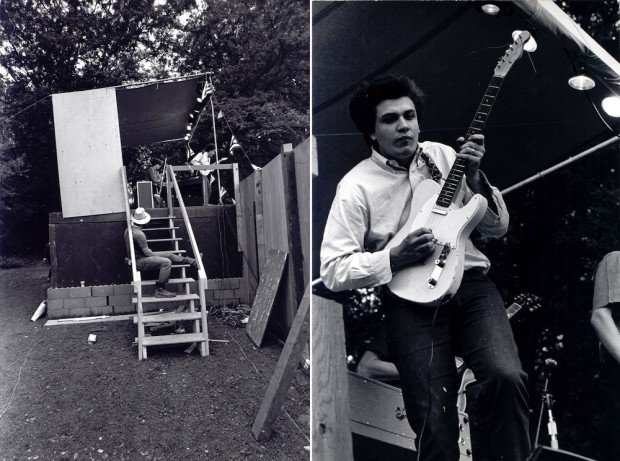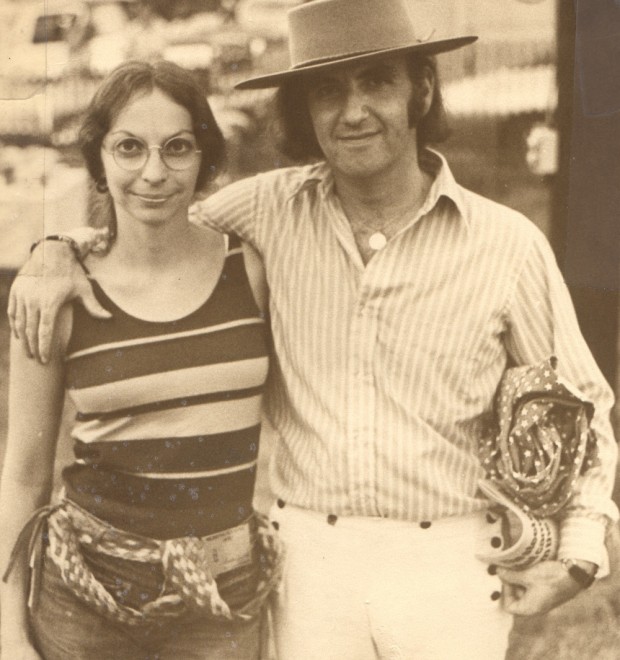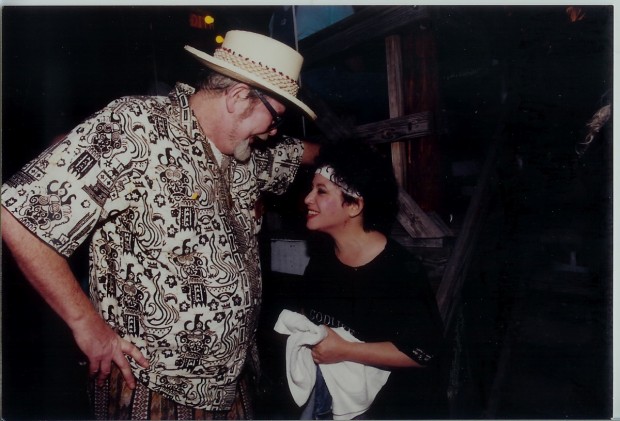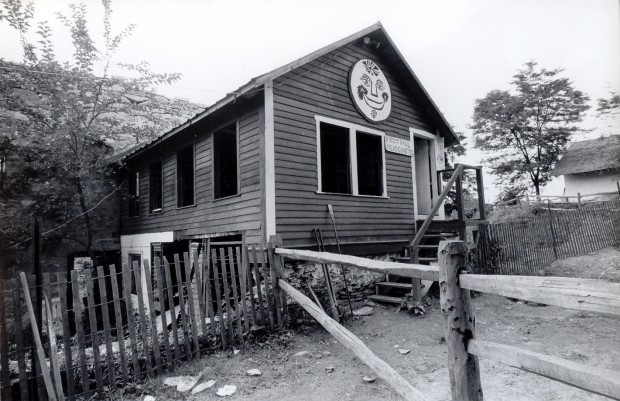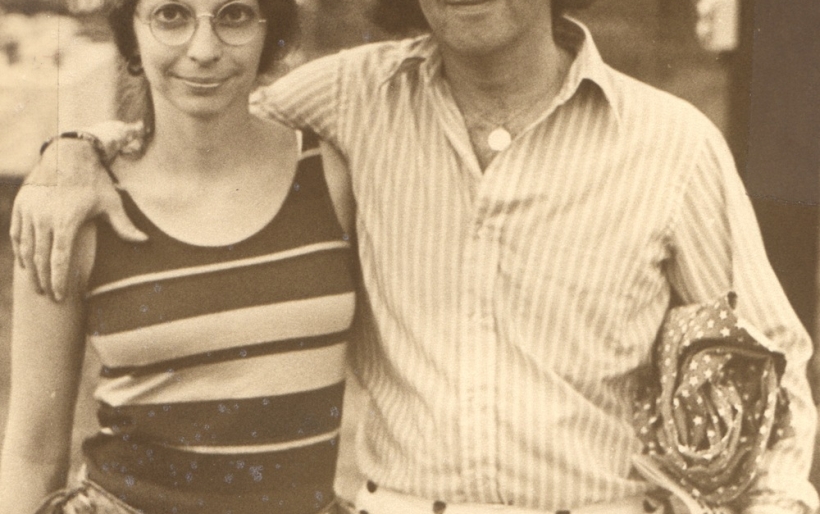
Gene Shay takes us through the Philadelphia Folk Festival photo album
Five decades can contain a lot of history, especially in the world of folk music. Thankfully, Gene Shay has an incredible memory. With the 51st Philadelphia Folk Festival descending on Schwenksville this weekend, we sat down with Shay and a collection of photos from the Folksong Society archives to get a picture of where the festival began and how far it has come.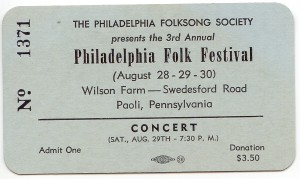 The scene you see above is Wilson Farm in Paoli, the location of the very first Philadelphia Folk Festival in 1962, and the three subsequent festivals through 1965. Shay remembers the owner of the land, C. Colket “Collie” Wilson, as a patron of the arts in the Philadelphia region. “The Pennsylvania Ballet needed a place to rehearse during the summer, and he said ‘I’ll build a stage.’ There was no canopy, no sides, just an open platform on cinderblocks. The dancers would come and rehearse, swim in the swimming pool when they were exhausted. And that was the stage he offered us. He thought it would be nice to have somebody out there other than the ballet. There was an old barn, that was built in the 1700s; it was in ruins when we were there, but people used to play guitar along its wall.”
The scene you see above is Wilson Farm in Paoli, the location of the very first Philadelphia Folk Festival in 1962, and the three subsequent festivals through 1965. Shay remembers the owner of the land, C. Colket “Collie” Wilson, as a patron of the arts in the Philadelphia region. “The Pennsylvania Ballet needed a place to rehearse during the summer, and he said ‘I’ll build a stage.’ There was no canopy, no sides, just an open platform on cinderblocks. The dancers would come and rehearse, swim in the swimming pool when they were exhausted. And that was the stage he offered us. He thought it would be nice to have somebody out there other than the ballet. There was an old barn, that was built in the 1700s; it was in ruins when we were there, but people used to play guitar along its wall.”
Shay calls this “Impromptu rain protection.” Onstage is sitar player Ali Akbar Khan, it’s the 1965 festival and the volunteers are stretching a tarp across the stage to cover the microphones and performers. “It was either that, or the show would be discontinued, and we were reluctant to close a stage down. So in this case, we had stage hands hold the tarp and the crowd wrapped themselves up in rain coats and still enjoyed the show.”
John Prine and Bonnie Raitt in the crowd, thumbing through the festival program and watching performances circa 1972. “This is one of my favorites,” Shay says. “She looks so incredibly young. The performers when they’re done their set hang out in the audience sometimes, watching the rest of the festival. It’s very informal.”
The Paul Butterfield Blues Band played the festival in 1966, on a high stage at the bottom of a ski slope at Spring Mountain. “It was much too steep,” remembers Shay. “Since the hill was made for skiing, people didn’t really have a nice place to lie down in their blanket. You’d slide into the person in front of you! People would get up to applaud, sit back down and find themselves two feet further down the hill. It did not work out well because of the contour of the land, but while we were there, we found out about Old Pool Farm, which is right nearby. We’ve been there ever since.”
A hallmark of the Old Pool Farm location is the campground scene with the various group encampments and informal / semi-formal song circles that run until dawn. One camp that first-time campers quickly find out about is the Azzoles. Not because they live up to their cheeky name, mind you – quite the contrary – but because they raise a massive flagpole that’s visible from everwhere in the campground. They’ve been camping, and running their performer’s circle, since the first year at Old Pool. “These people are third, fourth generation,” Shay says. “Some people come, some people go. They grow up, have kids, their kids come to the festival. Their kids grow up, their kids have kids. And then you’ve got the grandparents there, and their whole family in tow.”
“Hippies invade folk fest!” exclaims Shay, chuckling. That’s him on the right, with his wife Gloria, arriving at the 1971 Philadelphia Folk Festival from the performer’s parking lot. He’s carrying a program, a jacket and wearing a “modified gaucho hat” that was his regular attire while working at Elkman Advertising Agency in Philadelphia. “That was the year Fraser and Debolt played,” Shay remembers. “Daisy DeBolt wanted me to give her that jacket and I said ‘Like hell I’m giving it to you!’ She said it was an old custom, giving people your clothes that they admire. And I said ‘Yeah, not this time.'” Bonus Material: Check out a video of Fraser and Debolt playing the festival that year (sans Gene’s jacket) on YouTube.
Backstage at the Philadelphia Folk Festival in 1968, Dave Van Ronk chatting up seventeen-year-old Janis Ian. “It looks like they’re arguing,” Shay says. “But that’s just how Dave was – a big gruff guy who liked to get up close and personal when he talked.”
Back at the Wilson Farm in the early 60s, this was the Folk Fest HQ that housed security, volunteers, ticketing – the whole shebang of operations that are now spread out over numerous buildings across the festival grounds. Along the roof, you’ll see an early, hex-sign-like rendering of
the Philadelphia Folk Festival logo, a sunburst face on a banjo case. Shay’s advertising company was involved in creating the design, which has become an iconic circular insignia; the early versions, however, were longer, vertical and more obviously an instrument. “It was a long, narrow poster the first year we had the logo, so it had the whole neck of the banjo,” Shay recalls. “As we got bigger, and started to get a lot more artists, we decided to take the banjo neck away, and keep the circle down at the bottom. Once we did that, people didn’t always know that it was part of a banjo. Which is good, people have seen the logo as different things. Festival committees will use it in different ways. The electric committee, for example, might turn it into a light bulb. At 2nd Street Festival last weekend, I took a picture of a tattoo artist who had it on his arm!”
The 51st Philadelphia Folk Festival begins on Thursday Aug. 16 and runs through Sunday Aug. 19 at the Old Pool Farm in Schwenksville. Check back throughout the week for continuing Folk Fest coverage; tomorrow, we’ll talk with Helen Leicht about her picks for the Philly Local showcase on Saturday.



